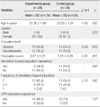Abstract
Purpose
This study was conducted to examine the effects of simulation-based education regarding care in a cardio-pulmonary emergency care as related to knowledge, clinical performance ability, and problem solving process in new nurses.
Methods
An equivalent control group pre-post test experimental design was used. Fifty new nurses were recruited, 26 nurses for the experimental group and 24 nurses for the control group. The simulation-based cardio-pulmonary emergency care education included lecture, skill training, team-based practice, and debriefing, and it was implemented with the experimental group for a week in May, 2009. Data were analyzed using frequency, ratio, chi-square, Fisher's exact probability and t-test with the SPSS program.
Results
The experimental group who had the simulation-based education showed significantly higher know-ledge (t=5.76, p<.001) and clinical performance ability (t=5.86, p<.001) for cardio-pulmonary emergency care compared with the control group who had traditional education but problem solving process was not included (t=1.11, p=.138).
Conclusion
The results indicate that a simulation-based education is an effective teaching method to improve knowledge and clinical performance ability in new nurses learning cardio-pulmonary emergency care. Further study is needed to identify the effect of a simulation-based team discussion on cognitive outcome of clinical nurses such as problem solving skills.
Figures and Tables
Figure 1
Research design.
Exp.=experimental group; Cont.=control group; CPA=clinical performance ability; PSP=problem solving process; SBE=simulation based education; LBE=lecture based education.

Figure 2
Development and process of simulation based education on cardiopulmonary emergency care.
ACLS=advanced cardiac life support; CPR=cardiopulmonary resuscitation.

References
1. Ackermann AD, Kenny G, Walker C. Simulator programs for new nurses' orientation. Journal for Nurses in Staff Development. 2007. 23:136–139.
2. Alinier G, Hunt WB, Gordon R. Determining the value of simulation in nurse education: Study design and initial results. Nurse Education in Practice. 2004. 4:200–207.
3. American Heart Association. Advanced cardiovascular life support. 2006a. Dallas, TX: American Heart Association.
4. American Heart Association. Basic life support for healthcare providers. 2006b. Dallas, TX: American Heart Association.
5. Back CY. Effects of advanced cardiac life support simulation-based training on nurses' competence in critical care setting. 2006. Seoul: Yonsei University;Unpublished master's thesis.
6. Bond WF, Spillane L. The use of simulation for emergency medicine resident assessment. Academic Emergency Medicine. 2002. 9:1295–1298.
7. Brannan JD, White A, Bezanson JL. Simulator effects on cognitive skills and confidence levels. The Journal of Nursing Education. 2008. 47:495–500.
8. Bremner MN, Aduddell K, Bennett DN, VanGeest JB. The use of human patient simulators best practices with novice nursing students. Nurse Educator. 2006. 31:170–174.
9. Chen PT, Cheng HW, Yen CR, Yin IW, Huang YC, Wang CC, et al. Instructor-based real-time multimedia medical simulation to update concepts of difficult airway management for experienced airway practitioners. Journal of the Chinese Medical Association. 2008. 71:174–179.
10. Crofts JF, Draycott TJ, Winter C, Hunt LP, Akande VA. Change in knowledge of midwives and obstericians following obsteric emergency training: A randomized controlled trial of local hospital, simulation centre and teamwork training. BJOG: An International Journal of Obstetrics and Gynaecology. 2007. 114:1534–1541.
11. Hoyt P. An international approach to problem solving for better health nursing™(PSBHN). International Nursing Review. 2007. 54:100–106.
12. Jeffries PR. A framework for designing, implementing, and evaluating simulations used as teaching strategies in nursing. Nursing Education Perspectives. 2005. 26:96–103.
13. Kang LW, Lee EJ. A Study on new nurse's job analysis for improvement of efficiently nursing educational curriculum. Journal of Gachon. 2001. 29:59–73.
14. Kim NY. The effects of web-based evidence-based nursing job education on the job knowledge, performance and motivation. 2005. Gwangju: Chonnam National University;Doctoral dissertation.
15. Kim YM, Oh YM, Kim HJ, Lee WJ, Im TH, Chung HS, et al. Development and pilot applications of simulation-based comprehensive emergency airway management courses. Journal of The Korean Society of Emergency Medicine. 2007. 18:1–9.
16. Ko CH. The effect of simulation-based training on the competence of basic life support of the students emergency medical technology. Journal of the Korean Society of Emergency Medical Technology. 2007. 11(3):31–45.
17. Lee JS. The effects of process behaviors on problem solving performance on various test. 1978. Chicago, USA: University of Chicago;Doctoral dissertation.
18. Lim NY, Yun SN, Kim JE, Lee YS, Jung YY, Song JH. Frequency and importance of nurse's job in new graduate nurses working in musculoskeletal ward. Journal of Rheumatology Health. 2003. 13:108–118.
19. McCausland LL, Curran CC, Cataldi P. Use of human simulator for undergraduate nurse education. International Journal of Nursing Education Scholarship. 2004. 1:Article23.
20. Medley CF, Horne C. Using simulation technology for undergraduate nursing education. Journal of Nursing Education. 2005. 44:31–34.
21. Nehring WN, Lashley FR. Current use and opinions regarding human patient simulators in nursing education: an international survey. Nursing Education Perspectives. 2004. 25:244–248.
22. Oh SH, Jang KS, Choi JY. Protocol development of cardiopulmonary resuscitation nursing tasks targeting patients with ventricular fibrillation generation. Journal of Korean Academy of Nursing Administration. 2009. 15:203–215.
23. Park JW, Woo OK. The effect of PBL (problem-based learning) on problem solving process by learner's metacognitive level. Journal of Educational Technology. 1999. 15(3):55–81.
24. Ragsdale MA, Mueller J. Plan, do, study, act model to improve an orientation program. Journal of Nursing Care Quality. 2005. 20:268–272.
25. Silvestri LA. Saunders Q & A Review for NCLEX-RN. 2002. Philadelphia, PA: W. B. Saunders Company.
26. Steinwachs B. How to facilitate a debriefing. Simulation Gaming. 1992. 23:186–195.
27. Turcato N, Robertson C, Covert K. Simulation-based education: What's in it for nurse anesthesia educators? AANA Journal. 2008. 76:257–262.
28. Wayne DB, Butter J, Viva J, Fudala MJ, Lindquist LA, Feinglass J, et al. Simulation-based training of internal medicine residents in advanced cardiac life support protocols: A randomized trial. Teaching and Learning in Medicine. 2005. 17:210–216.
29. Yang JJ. Development and evaluation of a simulation-based education course for nursing students. Journal of Korean Academy of Adult Nursing. 2008. 20:548–560.




 PDF
PDF ePub
ePub Citation
Citation Print
Print





 XML Download
XML Download